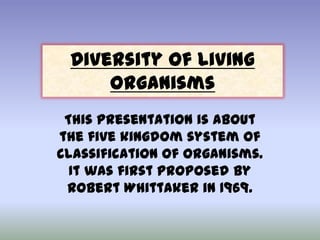Five kingdom Classification System
•Télécharger en tant que PPTX, PDF•
7 j'aime•8,668 vues
This is a presentation about the five kingdom system given by Robert Whittaker in 1969. The 5 kingdoms are :- Monera, Protista, Fungi, Plantae and Animalia.
Signaler
Partager
Signaler
Partager

Recommandé
Contenu connexe
Tendances
Tendances (20)
5 kingdom classification | Whittaker classification

5 kingdom classification | Whittaker classification
En vedette
En vedette (20)
Cell (for EDTECH 213 class 2nd Semester AY 2013-2014

Cell (for EDTECH 213 class 2nd Semester AY 2013-2014
Copy; keynote; ch. 3; cell structure & function copy.ppsx

Copy; keynote; ch. 3; cell structure & function copy.ppsx
Similaire à Five kingdom Classification System
Similaire à Five kingdom Classification System (20)
Kingdom classification and details classification of kingdom and phyllum 

Kingdom classification and details classification of kingdom and phyllum
Dernier
https://app.box.com/s/7hlvjxjalkrik7fb082xx3jk7xd7liz3TỔNG ÔN TẬP THI VÀO LỚP 10 MÔN TIẾNG ANH NĂM HỌC 2023 - 2024 CÓ ĐÁP ÁN (NGỮ Â...

TỔNG ÔN TẬP THI VÀO LỚP 10 MÔN TIẾNG ANH NĂM HỌC 2023 - 2024 CÓ ĐÁP ÁN (NGỮ Â...Nguyen Thanh Tu Collection
https://app.box.com/s/x7vf0j7xaxl2hlczxm3ny497y4yto33i80 ĐỀ THI THỬ TUYỂN SINH TIẾNG ANH VÀO 10 SỞ GD – ĐT THÀNH PHỐ HỒ CHÍ MINH NĂ...

80 ĐỀ THI THỬ TUYỂN SINH TIẾNG ANH VÀO 10 SỞ GD – ĐT THÀNH PHỐ HỒ CHÍ MINH NĂ...Nguyen Thanh Tu Collection
Dernier (20)
Kodo Millet PPT made by Ghanshyam bairwa college of Agriculture kumher bhara...

Kodo Millet PPT made by Ghanshyam bairwa college of Agriculture kumher bhara...
Food safety_Challenges food safety laboratories_.pdf

Food safety_Challenges food safety laboratories_.pdf
Interdisciplinary_Insights_Data_Collection_Methods.pptx

Interdisciplinary_Insights_Data_Collection_Methods.pptx
Beyond_Borders_Understanding_Anime_and_Manga_Fandom_A_Comprehensive_Audience_...

Beyond_Borders_Understanding_Anime_and_Manga_Fandom_A_Comprehensive_Audience_...
ICT role in 21st century education and it's challenges.

ICT role in 21st century education and it's challenges.
TỔNG ÔN TẬP THI VÀO LỚP 10 MÔN TIẾNG ANH NĂM HỌC 2023 - 2024 CÓ ĐÁP ÁN (NGỮ Â...

TỔNG ÔN TẬP THI VÀO LỚP 10 MÔN TIẾNG ANH NĂM HỌC 2023 - 2024 CÓ ĐÁP ÁN (NGỮ Â...
General Principles of Intellectual Property: Concepts of Intellectual Proper...

General Principles of Intellectual Property: Concepts of Intellectual Proper...
HMCS Vancouver Pre-Deployment Brief - May 2024 (Web Version).pptx

HMCS Vancouver Pre-Deployment Brief - May 2024 (Web Version).pptx
On National Teacher Day, meet the 2024-25 Kenan Fellows

On National Teacher Day, meet the 2024-25 Kenan Fellows
80 ĐỀ THI THỬ TUYỂN SINH TIẾNG ANH VÀO 10 SỞ GD – ĐT THÀNH PHỐ HỒ CHÍ MINH NĂ...

80 ĐỀ THI THỬ TUYỂN SINH TIẾNG ANH VÀO 10 SỞ GD – ĐT THÀNH PHỐ HỒ CHÍ MINH NĂ...
UGC NET Paper 1 Mathematical Reasoning & Aptitude.pdf

UGC NET Paper 1 Mathematical Reasoning & Aptitude.pdf
Five kingdom Classification System
- 1. Diversity of Living Organisms This presentation is about the five kingdom system of classification of organisms. It was first proposed by Robert Whittaker in 1969.
- 2. Five-Kingdom System • Once upon a time, all living things were lumped together into two kingdoms, namely plants and animals. • Animals included every living thing that moved, ate, and grew to a certain size and stopped growing. Plants included every living thing that did not move or eat and that continued to grow throughout life. • It became very difficult to group some living things into one or the other, so early in the past century the two kingdoms were expanded into five kingdoms: Protista (the single-celled eukaryotes); Fungi (fungus and related organisms); Plantae (the plants); Animalia (the animals); Monera (the prokaryotes). • Many biologists now recognize six distinct
- 3. • Monera is a kingdom that contains unicellular organisms without a nucleus (i.e., a prokaryotic cell organization), such as bacteria. • Monera is further divided into two subkingdoms: Archaebacteria and the Eubacteria by Carl Woese. 1. Archaebacteria:- Most archaebacteria are autotrophs and only a few, photosynthesize. They derive their energy from their metabolic activities, from the oxidization of chemical energy sources such as the reduced gases – Ammonia (NHO₃) , hydrogen sulphide (H₂S), etc. 2. Eubacteria:- Bacteria constitute a large domain or kingdom of prokaryotic microorganisms Typically a few micrometeres in length, bacteria have a wide range of shapes, ranging from spheres to rods and spirals. Bacteria were among the first life forms to appear on Earth.
- 4. Protista (Protocista) • This group includes many kinds of unicellular eukaryotic organisms such as unicellular algae, protozoans and unicellular fungi. Some of these organisms use appendages, such as hair-like cilia or whip like flagellum. Their mode of nutrition can be autotrophic or heterotrophic. • Examples:-
- 5. Fungi • • • Kingdom, Fungi, is separate from plants, animals, protis ts and bacteria. One major difference is that fungal cells have cell walls that contain chitin, unlike the cell walls of plants and some protists, which contain cellulose, and unlike the cell walls of bacteria. Their body is filamentous and multicellular and is called mycelium and the thread like structure is called hyphae. They include lichens too.
- 6. Plantae • Plantae includes all heterotrophic multicellular organisms. • They are eukaryotes ie their each cell has a well defined nucleus. • Reserve food for plants is starch and and lipids. • Growth in plants is generally indefinite due to presence of growing points. • Body form of the plants is irregular due to presence of branches.
- 7. Animalia • They are eukaryotic and multicellular organisms. • The cell wall is absent. • They are heterotrophic and hunt for their own food. • The locomotion is with the help of special organs like foot.
